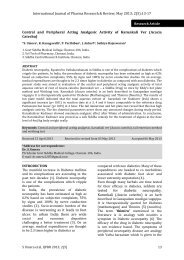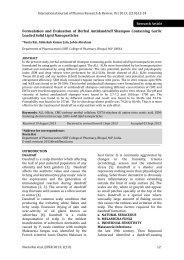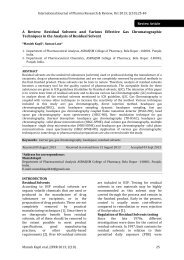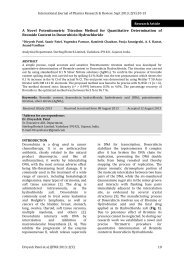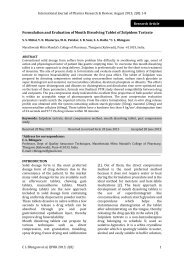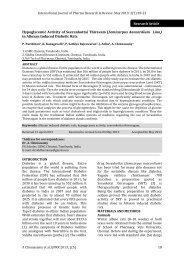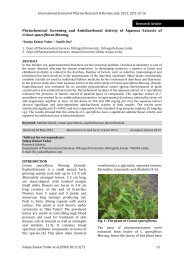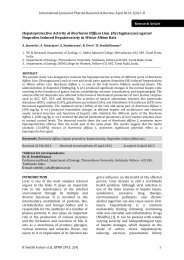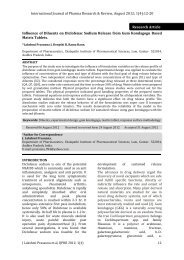Novel Approaches for Brain Drug Delivery System-Review
Novel Approaches for Brain Drug Delivery System-Review
Novel Approaches for Brain Drug Delivery System-Review
- No tags were found...
Create successful ePaper yourself
Turn your PDF publications into a flip-book with our unique Google optimized e-Paper software.
International Journal of Pharma Research & <strong>Review</strong>, June 2013; 2(6):36-44 ISSN: 2278-6074residence times.In fact, thesenanocarrierscan be taken up actively by carrier–mediated transport (CMT), receptormediatedendocytosis (RME) andadsorptive-endocytosis (AME) and hencereaches the cerebral parenchyma, or isdegraded within lysosomes leading to thedrug being released into the brain tissues.LiposomesLiposomes are small vesicles (usuallysubmicron-sized) comprising of one ormore concentric bilayers of phospholipidsseparated by aqueous compartments. It hasalso been suggested that liposomes couldenhance drug delivery to the brain acrossthe BBB. Although liposomes have beenreported to enhance the uptake of certaindrugs into the brain after intravenousinjection.Liposomes are sterically stabilized byattaching ligands to the surface of theliposomes [28-29].A recent application of transferrin surfaceconjugatedliposomes includes the deliveryof the anticancer drug 5- fluorouracil (5-FU)to brain. 5-FU is one of the most powerfulanticancer agents, but cannot reach aneffective concentration in the brain tumorcells when administered systemically.Modified liposomes have also been used <strong>for</strong>enhanced gene delivery to brain tumors.Fig. 5: Schematic representation of the different Pharmaceutical carriers <strong>for</strong> drugpenetration across the BBB.NanoparticlesNanoparticles (NPs) are solid colloidalparticles made up of polymeric materialsranging in size from 1-1000 nm. Thisdefinition includes both nanocapsules, witha core-shell structure (a reservoir system),and nanospheres (a matrix system). NPs areused as a carrier systems in which the drugis dissolved, entrapped, encapsulated,adsorbed or chemically linked to the surface[30].NPs possess the advantage of a high drugloading capacity and can provide protectionagainst chemical and enzymaticdegradation. Examples of syntheticpolymers used to prepare NPs are poly(alkylcyanoacrylate) (PACA), acryliccopolymers, poly(D,L-lactide-co-glycolide),and poly(lactide). NPs have also beenprepared from natural proteins (albuminand gelatin) and polysaccharides, starchand chitosan).Like liposomes, NPs are rapidly clearedfrom the blood following intravenousadministration. As carriers <strong>for</strong> drug deliveryto the brain, NPs need to be small (



